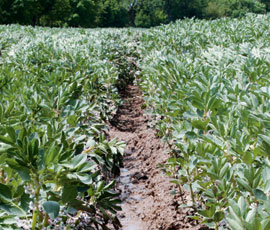Disease and poor pod set spell trouble for winter beans

The very low numbers of pods set on many of this year’s winter bean crops are due to a combination of factors, both seasonal and agronomic, said Becky Ward, PGRO’s principal technical officer.
Early drilling at high seed rates, followed by cool, cloudy conditions with plenty of rainfall, mean that crops are very tall and dense, she explained.
“Much of the growth has gone into the stem and foliage, rather than pod set,” she said. “Crops are too thick, light hasn’t been able to penetrate the over-thick canopies very well and we’ve had higher rainfall levels than normal, which has kept them growing.”
The cool, cloudy conditions which occurred for much of the spring and early summer also had an effect on pollinating insect numbers, she added.
“There were low levels of pollination by these insects, as it was too cold for them and conditions didn’t suit their activity. And even though beans are self-pollinating too, the thickness of crops prevented this process from taking place as it should.
“The outcome is that many crops have failed to set pods. Others have pods on the bottom and top trusses, but none on the middle trusses. So in these crops, yields are likely to be down.”
Huge disease pressure, mainly from chocolate spot, has also been experienced by winter beans, noted Ms Ward. “The combination of very dense canopies and unsettled weather conditions means that we’ve seen a lot of disease. Leafy varieties, such as Clipper, have more disease in them.”
“There were low levels of pollination by these insects, as it was too cold for them and conditions didn’t suit their activity. And even though beans are self-pollinating too, the thickness of crops prevented this process from taking place as it should.”
Becky Ward
Crops with higher plant populations are also more affected, she said. “It shows the importance of aiming for a plant population of 18 plants/sq m with winter beans.”
Improving the performance of field beans is the aim of a TSB-funded project, in which PGRO is leading the agronomy work, she added.
“We’re looking at sowing date and plant populations, in both winter and spring beans, to see if we can improve yield responses. We’re also looking at the timings of fungicide and insecticide applications.”
Three different sowing dates and four target plant populations are being investigated this year. “We don’t have any final results yet, but we have observed higher levels of both rust and chocolate spot in earlier drilled crops and where higher plant populations have been established.”
| Varieties |
|---|
| Several new spring bean varieties are showing promise, reported Steven Belcher. Of the recommended choices, both Pyramid and Fury are higher yielding than market leader Fuego, while Babylon is slightly lower yielding, but has better downy mildew resistance, he noted. Two varieties considered for the 2012 list but deferred for a year will be re-considered for 2013, he added. “Boxer is the highest yielding spring bean, but it couldn’t be added to the list as it didn’t have DUS, which isn’t unusual with spring beans. It has remained in trials and looks promising.” The other, Obelisk, was deferred for its poor downy mildew rating. “Again, it has been re-sown and time will tell how it has fared.” Three new candidate varieties from LSPB, Fabelle, Fanfare and Vertigo, are all showing high yield potential, he added. The newest recommended winter bean, Honey, is likely to replace Sultan, suggested Mr Belcher. “Sultan is a short, early bean which sets its pod a bit too low to the ground for some growers. It makes harvesting very difficult.” Old favourite Wizard is setting pods higher this year than last. “The moisture has helped.” Newly recommended pea varieties for 2012 include Kenzzo, a white pea, and the large blues Daytona and Ragtime. “The marrowfat Neon will be considered for full recommendation this year, while Strada is in its first year of trials.” Candidates include Kayanne, another white pea, the large blue Stratford and two marrowfats, Bibao and Scholar. |
Lupins
Spring-sown lupins are being evaluated at PGRO, as part of a larger research project on developing a growing system for UK grain lupins, explained Anthony Biddle.
“Behind it is the need to reduce our reliance on imported soya and use them in animal feed,” he reported.
Lupin seed has a high protein content, together with good oil, he added. “There are three different types of lupins, but some are too late maturing for the UK.”
Focus is now on breeding alkali tolerant lines, which can be grown across the country.

